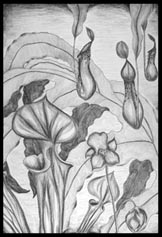CARNIVOROUS PLANTS
by Joelle Steele

Botanists and other scientists began recording their observations of carnivorous plants — often referred to as "plant curiosities" — as early as the 17th century. In the latter quarter of the 18th century, Dr. A.W. Roth recorded his observations of the Drosera species (Sun Dews) of carnivorous plants. But it was not until about a century later, in 1875, that Charles Darwin, then world-renowned and notably controversial for his 1859 work, "On the Origin of Species," wrote and published the first widely published treatise on carnivorous plants entitled "Insectivorous Plants." These unusual plants have been a fascination to botanists and gardeners ever since.
To be deemed carnivorous, a plant must be able to attract prey, kill it, and then digest it, absorbing necessary nutrients, such as amino acids, from that prey. Carnivorous plants are also called insectivorous because they often use insects and other small animals (mainly arthropods) as a source of those nutrients. When many people think of carnivorous plants, they tend to think of only the Venus Flytrap, but there are actually more than 600 species of carnivorous plants that produce digestive enzymes and absorb nutrients from their trapped prey. These species are grouped into about a dozen genera within five different plant families.

Illustration by Joelle Steele
Carnivorous plants are generally characterized by their ability to produce digestive enzymes, such as phosphatases, proteases, and ribonucleases. However, not all carnivorous plants produce those enzymes, and some instead use symbiotic bacteria to reduce their prey to a digestible commodity.
GROWING CONDITIONS
While there are so many species of carnivorous plants, they are still a rare form of plant. They grow in diverse habitats where other plants would have difficulty surviving at all. Most of them enjoy sunny locations and poor soil conditions, such as that found in bogs (which are usually very acidic due to the presence of sulfuric acid) and rocky soils (that drain well but provide little nitrogen.).
Carnivorous plants do not do well in soils containing calcium, and they like to be constantly wet or moist, with good humidity, although some species require a dormancy period during the warmer and drier seasons. The presence of good bright or indirect sunlight assures that these retain the colorful pigment in their foliage. While sunlight is important for the photosynthetic process, warmth is not always a necessity, since many carnivorous plants are native to cooler regions, some even tolerating or requiring subzero temperatures. Because these plants must always create specialized structures for their traps, they tend to be less efficient in "photosynthesis" (when the plant makes its own food) but tend to"respire" (when the plant uses its food to create leaves and other structures) more.
Their use of insects and arthropods provides carnivorous plants with the nutrients lacking in the poor soil where they grow. Each species varies in the degree to which it relies on trapped prey for nutrients, and while carnivorous plants will not die without insects to trap, their growth will likely be stunted to some extent, and so they tend to thrive in areas rich with insect life. Despite their insect-loving habits, carnivorous plants, when cultivated, become like many other non-carnivorous plants in that they are susceptible to predation by common plant pests such as aphids, mealybug, mites, and scale. In addition, carnivorous plants, whether cultivated or growing in the wild, are subject to death due to Botrytis cinerea (sooty mold), in warm, humid conditions.
TRAPS
Traps are generally the product of the primary leaf growth of the carnivorous plant. Some scientists believe that all traps are the genetic result of the evolution of stalked-glandular leaves that captured rainwater which induced the growth of bacteria which attracted insects which were trapped in the water, died, and then decayed, releasing nutrients that the plant absorbed through the leaves — something most other plants do anyway. However, using this theory, over time, some plants would have excelled in attracting insects to the point that they developed their traps into highly specialized mechanisms.
Some traps probably do not fit this scenario at all, such as the Brocchinia reducta species of bromeliad, a pitcher-type plant that produces a digestive enzyme but may not be a true carnivorous plant. Also, the Ibicella lutea has a sticky substance on its leaves which traps insects, but like the Passiflora foetida, it is uncertain as to whether either actually ingests nutrients from its trapped prey.
Traps can be active or passive, meaning there may or may not be movement involved in the trapping of prey. Traps may also include other substances, besides their digestive enzymes, that aid in securing or dissolving their prey.
There are five kinds of traps normally found in carnivorous plants:
Bladders. These suck the prey with a bladder that forms an internal vacuum.
Flypaper. These use a sticky substance called mucilage or glue.
Lobster pots. These induce the prey to move towards a digestive organ.
Pitfalls. These trap the prey in a pitcher formed by a rolled leaf containing a small reservoir of digestive enzymes.
Snaps. These traps rely on leaf movements that seal the prey in the trap.
If you decide to incorporate carnivorous plants into your landscape, be sure you use plants that are native to your part of the world, and then place them in an appropriate area of your garden where they will receive adequate sun, moisture, and the poor soil conditions they need in which to thrive.

